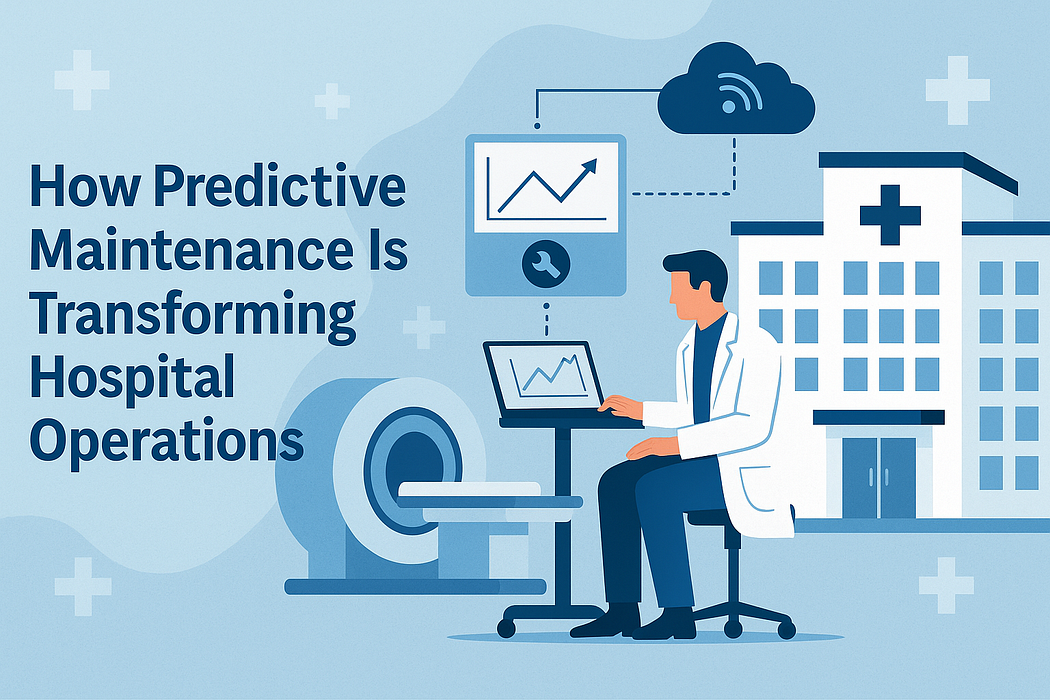How Predictive Maintenance Is Transforming Hospital Operations
Introduction
Hospitals face an invisible but critical threat every day: equipment failure. From ventilators to imaging machines, the malfunction of a single device can delay treatment, compromise patient outcomes, and even cost lives. According to GE Healthcare, over 60% of hospital equipment failures are preventable — yet many facilities still rely on reactive maintenance models.
But that’s changing fast.
The convergence of artificial intelligence (AI) and the Internet of Things (IoT) is giving rise to predictive maintenance, a proactive approach that helps hospitals detect issues before they happen. This shift doesn’t just reduce downtime — it saves costs, improves resource planning, and ensures uninterrupted care delivery.

In this post, we’ll explore how predictive maintenance powered by AI and IoT is transforming hospital operations, what makes it so effective, and how healthcare providers can leverage it to build smarter, safer systems. If you’re a healthcare IT decision-maker or innovation leader, this is your guide to staying ahead of the curve.
1. What Is Predictive Maintenance in Healthcare?
Predictive maintenance (PdM) uses real-time data, sensors, and machine learning models to anticipate equipment failures before they occur. Instead of servicing equipment at regular intervals (preventive) or after breakdown (reactive), PdM triggers maintenance based on actual usage patterns and predictive insights.
In a healthcare setting, this means:
· Monitoring the operational health of machines like MRI scanners, ventilators, dialysis systems.
· Using AI to detect anomalies that suggest wear or failure.
· Scheduling service only when needed — before breakdown occurs.
Example: A hospital’s imaging machine is fitted with IoT sensors. These sensors track vibrations, heat, and usage cycles. If data suggests a motor is degrading, the AI alerts the team to service the part — before a complete failure.
This model:
· Extends equipment lifespan
· Improves availability for patient care
· Reduces emergency repair costs
The Role of AI and IoT in Smart Hospital Maintenance
AI and IoT are the two core enablers of predictive maintenance.
· IoT Devices: These include smart sensors embedded in hospital equipment to gather data like temperature, vibration, power usage, and operating hours.
· AI Algorithms: Machine learning models process this data to detect abnormalities, predict failure timelines, and prescribe optimal maintenance schedules.
This combination allows hospitals to move from calendar-based maintenance to condition-based intervention.
Benefits include:
· Faster fault detection
· Fewer false alarms compared to rule-based systems
· Tailored maintenance for different equipment types
Real-world example: At Tech4Biz Solutions, an IoT-enabled hospital solution reduced equipment failure rates by 35% in under 6 months by combining sensor data with AI-driven predictive models.
Key Operational Gains for Hospitals
Predictive maintenance isn’t just a tech upgrade — it delivers measurable impact across operations:
Reduced Equipment Downtime
With predictive alerts, hospitals avoid surprise failures, ensuring vital devices are always patient-ready.
Lower Maintenance Costs
Switching from routine servicing to condition-based maintenance cuts labor and parts replacement costs.
Improved Patient Safety
Timely maintenance ensures life-saving machines work without failure during critical moments.
Better Compliance and Audits
Digital logs of maintenance activities help hospitals meet regulatory standards and simplify audits.
Example: A multi-specialty hospital using predictive models saw: Implementation Roadmap for Hospitals
Adopting predictive maintenance requires both strategic vision and practical steps. Here’s a typical implementation flow:
1. Audit Existing Equipment: Identify high-priority systems (e.g., imaging, ICU devices) and current failure trends.
2. Sensor Deployment: Install IoT sensors or integrate existing telemetry systems with a central data lake.
3. Data Aggregation: Use cloud infrastructure or edge computing to store and process device data.
4. Model Training: Build or integrate AI models that analyze historical and live data to detect faults.
5. Workflow Integration: Connect AI alerts to your hospital’s CMMS (Computerized Maintenance Management System).
6. Staff Training: Train biomedical and facility teams to interpret AI predictions and act accordingly.
Pro Tip: Start small with one department (e.g., radiology) before scaling system-wide.
· 28% reduction in emergency service requests
· 40% improvement in first-time fix rates
· Better SLA compliance with equipment vendors
Conclusion
Hospitals today must run like high-precision machines themselves. In an environment where every second counts, predictive maintenance powered by AI and IoT is no longer optional — it’s essential. This shift isn’t just about technology; it’s about saving lives, optimizing resources, and delivering on the promise of digital healthcare.
By implementing predictive systems, hospitals can:
· Minimize unexpected downtimes
· Extend equipment life
· Improve operational efficiency
If you’re a hospital administrator, IT director, or MedTech innovator, now is the time to ask: Is your hospital ready to move from reactive to predictive?


Comments
Post a Comment